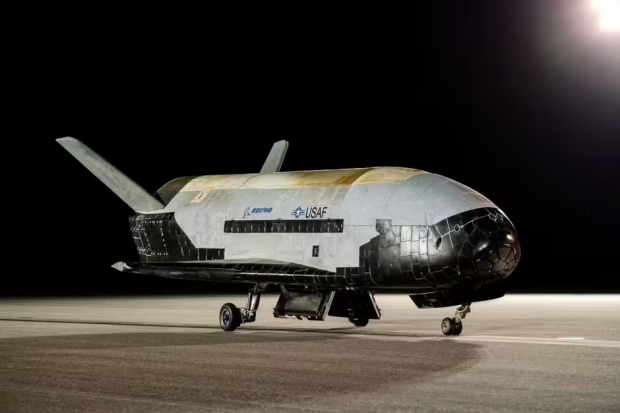
The US Space Force’s top-secret X-37B space plane is about to make history as it prepares to execute a groundbreaking maneuver, potentially altering its orbit and allowing it to operate undetected by hostile nations. The Boeing-built, unmanned craft is set to perform a series of “novel maneuvers” known as aerobraking. This technique has never before been attempted by the X-37B, and it promises to enhance the spacecraft’s capabilities while simultaneously adding a layer of secrecy to its operations. After a full year in outer space testing, the Boeing built craft has surpassed all expectations, but can it do it again?
A Maneuver Designed for Secrecy and Efficiency
Aerobraking is a method of slowing down a spacecraft by using the atmosphere or outer gas layers of a planet. As the X-37B dips into the Earth’s atmosphere, the molecules of gas create friction, acting as resistance and gradually slowing the craft down. This process can be carefully controlled to alter the spacecraft’s trajectory and reduce its orbital altitude.
The primary advantage of aerobraking is its fuel efficiency. Compared to traditional methods of orbital adjustment, which rely on rocket propulsion, aerobraking requires significantly less fuel. Furthermore, the maneuver can be conducted discreetly, potentially allowing the X-37B to evade tracking by ground-based sensors.
Expanding Capabilities in a Challenging Domain
While the X-37B’s exact purpose remains a closely guarded secret, it is thought to be involved in multiple tasks, including spy missions, satellite deployment, and even the testing of military surveillance technology. This aerobraking maneuver marks a significant advancement for the US Space Force, demonstrating their commitment to expanding their capabilities in space.
“This novel and efficient series of maneuvers demonstrates the Space Force’s commitment to achieving groundbreaking innovation as it conducts national security missions in space,” said Secretary of the Air Force Frank Kendall.
The Chief of Space Operations, Gen. Chance Saltzman, added, “This first-of-a-kind maneuver from the X-37B is a significant milestone for the United States Space Force as we seek to expand our aptitude and ability to perform in this challenging domain.”
A History of Innovation and Testing
The X-37B’s history is as fascinating as its current mission. Launched via rockets and capable of remaining in space for extended periods, the vehicle is 29 feet long and 9.5 feet tall. It is reusable, landing on a runway following each mission, making it ideal for conducting ongoing experiments and testing new technologies.
The X-37B has spent extended periods in orbit across six previous missions. Its previous tasks have included testing the impact of solar radiation, collecting data on the space environment, and conducting experiments on various technologies. While the specific details of these missions are classified, they underscore the X-37B’s importance as a testbed for cutting-edge technologies with potential military applications.
Potential Applications and Future Implications
The success of the aerobraking maneuver could have significant implications for future space missions. This technology could be applied to other spacecraft, enabling more efficient and stealthy orbital adjustments for tasks like planetary exploration, satellite deployment, and even the deployment of counter-space systems.
Furthermore, the X-37B’s ability to perform aerobraking adds to the growing debate surrounding the militarization of space. With its potential for covert operations and the ability to deploy various payloads, the X-37 B could be seen as a symbol of the increasing use of space for strategic purposes.
A New Era of Space Exploration and Security
As the X-37B prepares for this unprecedented maneuver, it reinforces the US Space Force’s commitment to pushing the boundaries of space technology and enhancing its capabilities in the challenging and ever-evolving space domain. The world will be watching as the X-37B embarks on its groundbreaking mission, potentially ushering in a new era of space exploration and national security, one where the lines between civilian and military space activities continue to blur.
